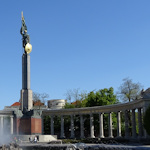One end of Schwarzenbergplatz square features a large stone colonnade and what looks like a figure bearing a shield with an incongruous Soviet emblem. Or not so incongruous as it turns out. This is the Soviet monument constructed after the Red Army captured Vienna in 1945.
- Large memorial to the soldiers who died liberating Vienna from fascism
- Notable for the black and gold soldier topping a huge marble column
- Join a guided walking tour* around WWII sites & memorials
- See also:
- WWII locations in Vienna
- Sights in Vienna
A monument to sacrifice

(Not the kind of weapon you normally see on Viennese monuments)
Cast your mind back to the spring of 1945, as Germany fell back before the combined onslaught of the Allies.
The Soviet army had pushed all the way from the east through to Vienna, intent on capturing the city from the Nazis (Austria having been annexed by Germany in the 1930s).
The resultant battles and street fighting across some ten days in April left thousands dead and further damaged a city already pummeled by bomber attacks. But the Soviets prevailed and Nazi rule in Vienna came to a welcome end.
The Heldendenkmal der Roten Armee (Heroes Monument of the Red Army) commemorates the thousands of Soviet soldiers who lost their lives during the Vienna offensive that eventually led to the “liberation” of the city.
(Liberation appears in quotation marks for a reason, since it depends on your perspective of Austrian culpability and acquiescence concerning Nazi occupation. Many argue the city was conquered not liberated. But let’s not get into that debate!)
The Red Army erected the monument themselves just a few months after entering Vienna to a design by their own officers, having already planned such a construction even before the city had been taken. They placed it within clear viewing distance of the Ring boulevard.

(Street fighting on April 7th, 1945 in front of damaged stalls at the Naschmarkt in a 1946 watercolour by Karl Hornstein; Wien Museum Inv.-Nr. 72608; excerpt reproduced with permission under the terms of the CC0 licence)
Not that the Viennese necessarily resented the building efforts of their liberators.
The city immediately took on responsibility for the monument, and leading national and local politicians spoke at the official opening on August 19th.
For example, the new Austrian chancellor noted (my rough translation of a report in the Das Kleine Volksblatt newspaper two days later):
The bold and heroic efforts of the Red Army, the Soviet soldiers’ sacred willingness to make sacrifices, and the masterful leadership of their generalissimo Stalin has destroyed the execrable people-enslaving fascist regime and initiated an epoch of permanent peace among the peoples of this earth.
I’m not a historian, but that last prediction hasn’t proved, shall we say, entirely correct.
The monument consists primarily of a long marble colonnade, though the stand out feature is the tall column in the centre. A soldier stands atop this column bearing a flag, a machine gun, and a golden shield.

(View across Schwarzenbergplatz with the Hochstrahlbrunnen fountain in the foreground)
The close proximity to the large fountain occupying the space in front of the curved colonnade is pure coincidence. The Hochstrahlbrunnen went up in the late 1800s at the opening of the first Alpine water pipeline into the city.
The same square also has the 1867 Schwarzenberg monument. This equestrian statue honours Karl Philipp, Prince of Schwarzenberg, who led, for example, the defeat of Napoleon at the 1813 Battle of Leipzig.
Inevitably, the Red Army monument remains somewhat contentious, despite its fundamental purpose honouring those who helped defeat fascism.
Vienna obviously accepts and honours the sacrifices made by the Soviet army in liberating the city (the authorities keep it in excellent condition). However, the occupation of Vienna brought its own problems.
(And memorials to the Soviet military have not necessarily aged well, even ignoring contemporary Russian foreign policy.)
Incidentally, if you’re interested in WWII and/or the modern post-Habsburg history of Vienna and Austria, you might like this guide to local WWII locations & memorials. Also consider a visit to the House of Austrian History in the town centre.
How to get to the monument
For travel tips, see the bottom of the article on the Hochstrahlbrunnen fountain.
P.S. Go past the Red Army monument to the east to find the entrance to the Belvedere palaces with their wonderful art exhibitions.
Address: Schwarzenbergplatz, 1030 Vienna
